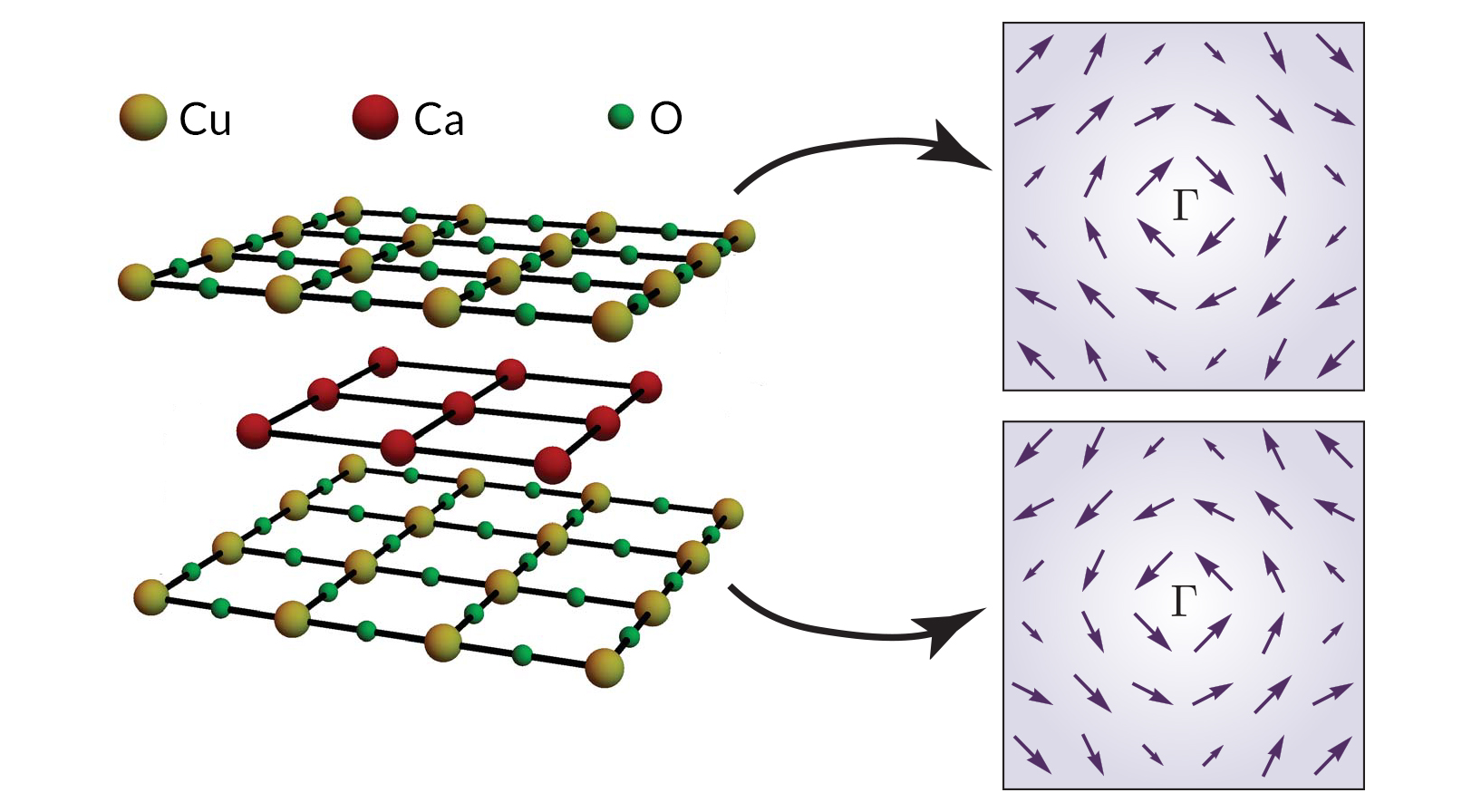SCIENTIFIC ACHIEVEMENT
A form of spin-momentum locking, similar to the strong linkage between electron spin and momentum in topological insulators, has been found in a cuprate superconductor.
SIGNIFICANCE AND IMPACT
The results open a new chapter in the mystery of high-temperature superconductors, suggesting that new, unexplored interactions and mechanisms might be at play.

“High temperature” superconductivity
In the world of superconductors, “high temperature” means that the material can conduct electricity without resistance at temperatures higher than expected, but still far below room temperature. Within this special class of high-temperature superconductors (HTSCs), cuprates—consisting of superconducting CuO2 layers separated by spacer layers—are some of the best performers, generating interest in these materials for potential use in super-efficient electrical wires that can carry power without any loss of electron momentum.
A new spin on cuprate HTSCs
Two kinds of electron interactions have been known to give rise to novel properties in new materials, including superconductors. Scientists who study cuprate superconductors have focused on just one of those interactions: electron correlation—electrons interacting with each other. The other kind of electron interaction found in exotic materials is spin-orbit coupling—the way in which an electron’s magnetic moment interacts with atoms in the material.
Spin-orbit coupling was often neglected in studies of cuprate superconductors because many assumed that this kind of interaction would be comparatively weak. But when a research team, led by staff from Berkeley Lab’s Materials Sciences Division, used a unique detector to measure samples of an exotic cuprate superconductor (Bi2Sr2CaCu2O8+δ, or Bi2212), they discovered the presence of strong spin-orbit coupling, resulting in a well-defined direction for each electron spin depending on its momentum, a property known as spin-momentum locking. This property is known to exist in topological insulators, but finding it in high-temperature superconductors was a surprise.
Spin-momentum locking revealed
Over the course of nearly three years, team members used a powerful technique called spin- and angle-resolved photoemission spectroscopy (SARPES) to simultaneously measure the energy, momentum, and spin of electrons ejected from Bi2212 samples by incoming photons. Initially, the team used a laser as a photon source, but when they needed higher photon energies to excite a wider range of electrons, they moved their detector to ALS Beamline 10.0.1.
The data revealed a distinct spin pattern—a correlation between momentum and spin polarization—for a wide range of photon energies. The pattern showed spins circling the Brillouin zone center, with a reversal of sign across Brillouin zone boundaries—an observation made possible by the range of tunable wavelengths, or photon energies, of ALS light. This reversal indicated that the photoemission experiment was probing the physics of the underlying electronic states of the material, as opposed to being an external effect caused by the way the incoming photons interacted with the material.

Toward a new understanding
The researchers developed a model to show how this pattern could emerge from a complex spin structure in real and momentum space. The layered structure of Bi2212 allows for a spin-momentum locking in one Cu-O layer of the unit cell that is matched by the opposite spin texture in the other Cu-O layer of the unit cell. This type of ordering is hidden from other experimental techniques, but SARPES was able to uncover this structure because it differentially samples noncanceling components of the electronic wave functions. The presence of meaningful spin-orbit effects in a cuprate HTSC means that, going forward, theories must consider how strong electron correlation interacts with spin-orbit coupling as the superconducting state emerges.

Contact: Alessandra Lanzara
Researchers: K. Gotlieb, C.-Y. Lin, C.L. Smallwood, and A. Lanzara (University of California, Berkeley, and Berkeley Lab); M. Serbyn (Institute of Science and Technology Austria); W. Zhang (Shanghai Jiao Tong University and Berkeley Lab); C. Jozwiak and Z. Hussain (ALS); H. Eisaki (National Institute of Advanced Industrial Science and Technology, Japan); and A. Vishwanath (Harvard University).
Funding: U.S. Department of Energy, Office of Science, Basic Energy Sciences Program (DOE BES); Gordon and Betty Moore Foundation; Ministry of Science and Technology of China; and National Natural Science Foundation of China. Operation of the ALS is supported by DOE BES.
Publication: K. Gotlieb, C.-Y. Lin, M. Serbyn, W. Zhang, C.L. Smallwood, C. Jozwiak, H. Eisaki, Z. Hussain, A. Vishwanath, and A. Lanzara, “Revealing hidden spin-momentum locking in a high-temperature cuprate superconductor,” Science 362, 1271 (2018), doi:10.1126/science.aao0980.
Adapted from the Berkeley Lab news release, “Revealing Hidden Spin: Unlocking New Paths Toward High-Temperature Superconductors.”
ALS SCIENCE HIGHLIGHT #390